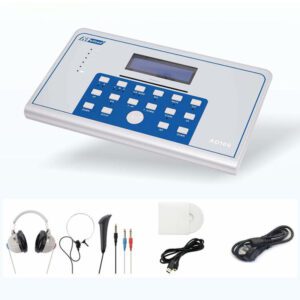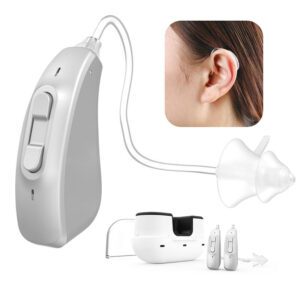hearing aid whistling is a common issue that can be categorized into two main types: internal whistling and external whistling. Each type has distinct causes and corresponding treatments.

Internal Whistling: Internal whistling, also known as internal acoustic feedback, is caused by problems within the hearing aid itself. Some potential causes and treatments include:
- Restricted Inner Space: If the internal components of the hearing aid are tightly packed, they can lead to feedback. Solution: Ensure proper assembly and spacing during manufacturing.
- Component Misplacement: Shaking or dropping the hearing aid might displace internal components. Solution: Gently handle the hearing aid to prevent internal shifts.
- Receiver and Sound Tube Connection: Inadequate connection between the receiver and sound tube can cause whistling. Solution: Check and secure the connections.
- Moisture Ingress: Moisture or water vapor entering the hearing aid can cause internal feedback. Solution: Protect the hearing aid from moisture and consider using a drying kit.
External Whistling: External whistling occurs when sound leaks from gaps between the hearing aid and the ear canal. Here are potential causes and remedies:
- Poor Fit: Incorrect placement of the hearing aid can lead to external whistling. Solution: Ensure proper fitting and positioning of the hearing aid.
- Improper Earplugs: If standard earplugs don’t seal well, sound can leak out. Solution: Replace with earplugs that provide a better fit.
- Unsealed Ear Mold: Incomplete sealing between the ear mold and the ear canal can result in whistling. Solution: Redo the ear mold to achieve a proper seal.
- Damaged Components: If any part of the earback machine is damaged, it can cause whistling. Solution: Replace damaged components like earplugs, sound tubes, and ear hooks.
- Broken Customized Shell: If the customized shell is damaged or doesn’t fit well, external whistling can occur. Solution: Redo the customized shell for a proper fit.
- Vent Issues: Problems with the vent, such as size or position, can lead to whistling. Solution: Ensure correct vent selection and placement.
- Improper Hearing Aid Programming: Poorly adjusted hearing Aids, especially with excessive high-frequency gain, can cause whistling. Solution: Re-adjust the hearing aid settings.
Distinguishing Internal and External Whistling:
- Frequency of Occurrence: If whistling is intermittent and loud, it’s more likely external. This could result from external factors rather than a hearing aid malfunction.
- Location of Sound: If the whistling sound is within the hearing aid and relatively soft, it’s likely internal feedback. A louder, external sound might indicate external whistling.
- Sound Hole Test: Covering the sound hole of the hearing aid with your hand can help differentiate. If you hear the whistling sound, it’s likely internal; if not, it’s likely external.
In conclusion, hearing aid whistling can be bothersome and impact comfort and audibility. Identifying the type of whistling and addressing the underlying causes promptly can help improve the overall hearing aid experience for users.


